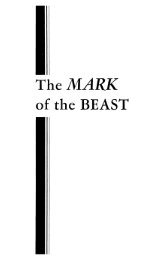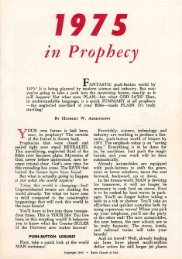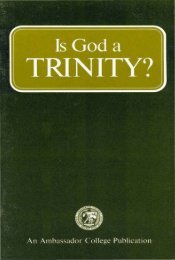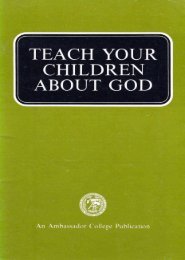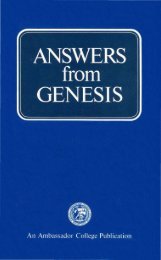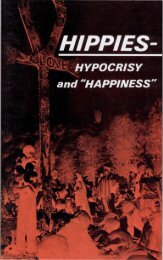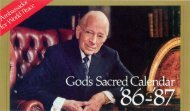The Crucifixion Was Not On Friday PDF - Church of God Faithful Flock
The Crucifixion Was Not On Friday PDF - Church of God Faithful Flock
The Crucifixion Was Not On Friday PDF - Church of God Faithful Flock
Create successful ePaper yourself
Turn your PDF publications into a flip-book with our unique Google optimized e-Paper software.
<strong>The</strong> <strong>Crucifixion</strong> <strong>Was</strong> <strong>Not</strong> on <strong>Friday</strong> 29beginning <strong>of</strong> A.D. 28, just befo re the first Passover in J esus'ministry.If the ministry <strong>of</strong> Christ began in any other year than theautumn <strong>of</strong> A.D. 27, then the temple would not have beenexactly 46 years in building by the time <strong>of</strong> the Passover in thespring <strong>of</strong> 28 A.D.Pro<strong>of</strong> Five: <strong>The</strong> Reign <strong>of</strong> Emperor Tiberius<strong>On</strong>e <strong>of</strong> the most vital keys to the chronology <strong>of</strong> Christ'sministry - and yet one <strong>of</strong> the most universally misunderstooddates- is the 15th year <strong>of</strong> the reign <strong>of</strong> Tiberius Caesar. Luketells us that John the Baptist began to preach in his 15th year(Luke 3: 1).When was this fifteenth year?<strong>The</strong> trouble arises from the fact that there are at leasttwo dates from which the reign <strong>of</strong> Tiberius Caesar may becounted- the first commences with his being made co-rulerwith Augustus Caesar, at the very end <strong>of</strong> A.D. 11 or the beginning<strong>of</strong> A.D. 12. <strong>The</strong> exact month is not known, but it isnot essential anyway. <strong>The</strong> second date begins with his sole rulein August, A.D. 14. Luke could have used either date and beenhistorically correct. But which one did he use?To be consistent with all the other facts, Luke must haveused the earlier date as the beginning <strong>of</strong> the reign <strong>of</strong> Tiberius.In fact, for the word "reign" Luke uses a Greek word meaning"government" in general, indicating that he did not mean hissole emperorship, but merely his elevation to joint authorityaboutthe end <strong>of</strong> A.D. 11 or beginning <strong>of</strong> A.D. 12.In determining the emperor's regnal year, Luke used thecustomary Jewish form, practiced also by Josephus. "Josephusalso . . . in order to avoid making the last year <strong>of</strong> one emperorcoincide with the first year <strong>of</strong> his successor, reckoned the finalyear <strong>of</strong> each emperor as continuing to the end <strong>of</strong> the currentyear, and made the first year <strong>of</strong> his sucessor begin [in] Aprilfollowing his accession," says the competent scholar W. M.Ramsey in his book <strong>Was</strong> Christ Born at Bethlehem?, page 223.This method which has but recently been understood, wasused by Luke also to determine imperial joint reigns. <strong>The</strong> first




